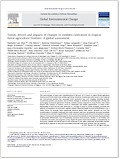| Journal Article |
 |
|
| Article Title | Trends, drivers and impacts of changes in swidden cultivation in tropical forest-agriculture frontiers: A global assessment | | Author | Nathalie van Vliet, Ole Mertz, Andreas Heinimann, Tobias Langanke, Unai Pascual, Birgit Schmook, Cristina Adams, Dietrich Schmidt-Vogt, Peter Messerli, Stephen Leisz, Jean-Christophe Castella, Lars Jørgensen, Torben Birch-Thomsen, Cornelia Hett, Thilde Bech-Bruun, Amy Ickowitz, Kim Chi Vu, Kono Yasuyuki, Jefferson Fox, Christine Padoch, Wolfram Dressler and Alan D. Ziegler | | Year | 2012 | | Journal Title | Global Environmental Change | | Institution | Elsevier Ltd | | Volume | 22 | | Pages | 418–429 | | Call Number | JA0524-14 | | Keywords | Land use change, Swidden cultivation, Drivers, Impacts, Forest-agriculture frontiers, Metaanalysis |
|
| Abstract: |
| This meta-analysis of land-cover transformations of the past 10–15 years in tropical forest-agriculture
frontiers world-wide shows that swidden agriculture decreases in landscapes with access to local, national
and international markets that encourage cattle production and cash cropping, including biofuels.
Conservation policies and practices also accelerate changes in swidden by restricting forest clearing and
encouraging commercial agriculture. However, swidden remains important in many frontier areas where
farmers have unequal or insecure access to investment and market opportunities, or where multifunctionality
of land uses has been preserved as a strategy to adapt to current ecological, economic and
political circumstances. In some areas swidden remains important simply because intensification is not a
viable choice, for example when population densities and/or food market demands are low. The
transformation of swidden landscapes into more intensive land uses has generally increased household
incomes, but has also led to negative effects on the social and human capital of local communities to varying
degrees.From an environmentalperspective, the transition from swidden to other land uses oftencontributes
to permanent deforestation, loss of biodiversity, increased weed pressure, declines in soil fertility, and
accelerated soil erosion. Our prognosis is that, despite the global trend towards land use intensification, in
many areas swidden will remain part of rural landscapes as the safety component of diversified systems,
particularly in response to risks and uncertainties associated with more intensive land use systems. |
|